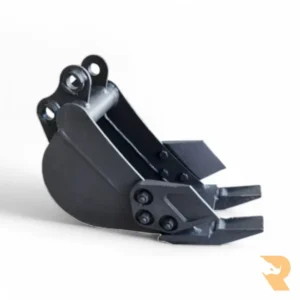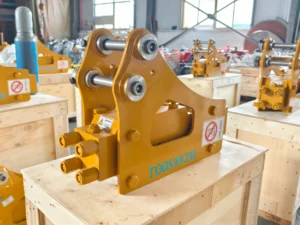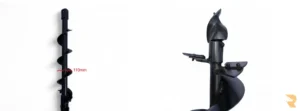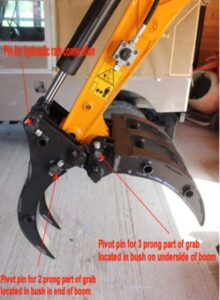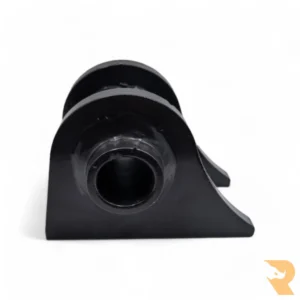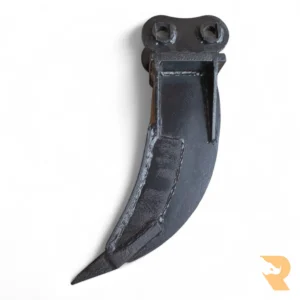Table of Contents
- Why Attachments Matter
- Common Mini Excavator Attachments and Their Uses
- How to Choose the Right Attachments for Your Job
- Final Tips
Why Attachments Matter
Mini excavators are powerful, compact machines, but their real value lies in their ability to adapt to different job site demands through the use of attachments. Key benefits include:
- Increased efficiency: Whether you’re trenching, grading, demolishing, or landscaping, the right attachment can dramatically improve your productivity.
- Cost-effectiveness: The right attachments can replace the need for multiple standalone tools or machines.
- Job flexibility: Handle a wide range of tasks—from digging and lifting to demolition and precision grading.
- Enhanced accuracy: Attachments like tilt rotators and grading buckets offer improved control and precision.
This guide explores the most commonly used mini excavator attachments, what they do, and how to choose the best ones for your specific job. Whether you’re a contractor, a landowner, or a weekend warrior, understanding the capabilities of mini excavator attachments will help you maximize your mini digger.
Common Mini Excavator Attachments and Their Uses
Below is a detailed look at the most popular mini excavator attachments
1. Buckets (Standard, Trenching, Grading)
Buckets are the most basic and essential attachment, but they come in several types and sizes. A few different types include:
- Standard Digging Bucket: Used for general-purpose digging and material handling.
- Trenching Bucket: While a standard digging bucket can be used for trenching, trenching buckets are usually narrower and more efficient utility trenching, pipe laying and more.
- Grading Bucket (or Ditching Bucket): This bucket is wider and shallower, and provides better and more efficient results in levelling and profiling ground.
There are over 10 different types of buckets, so choosing the right type and size can greatly benefit your project.
Tip: Opt for quick couplers to easily switch between bucket types during a project.
2. Hydraulic Breakers (Hammers)
Hydraulic breakers use forceful percussive power to break through tough materials like rock, asphalt, or concrete. These are great demolition projects, breaking driveways or foundations, and removing rocks.
3. Augers
Augers are drilling attachments that dig deep, narrow holes. If you want to install lots of fences over a farm, plant multiple trees, install signposts or foundation footings, then this attachment type is vital for consistent hole sizes quickly.
Tip: Augers come with different bit diameters – choose based on the job requirements.
4. Grapples
Grapples are claw-like attachments that allow you to grab and move irregular or bulky materials more efficiently than trying to pick them up with a bucket. For example:
- Log Grapple: Specifically designed for handling timber.
- Demolition Grapple: For sorting and loading debris. This can be great for site cleanup.
Tip: Great for landscape contractors or recycling operations dealing with non-uniform loads.
5. Thumb Attachments
Thumbs are hinged clamps that work with a bucket to grab and hold materials. Compared to a grapple, these may be better for rocks, and small bushes/trees, but could be worse if you process a lot of wood or larger demolition material.
Tip: Hydraulic thumbs offer better control than mechanical ones.
6. Rippers
Rippers are pointed tools used to penetrate and break apart compact soil, roots, or ice. It reduces the stress on the excavator if the ground is not already broken up. This can be great for quarrying and mining, agriculture, difficult areas, countries with permafrost and much more.
Tip: Ideal for prepping an area before switching to a bucket or auger.
7. Tilt Rotators
Tilt rotators allow attachments to rotate 360° and tilt up to 45° in either direction. This dramatically enhances control and access in tight spaces. This is best for precision grading, working around obstacles, or complex landscaping.
Tip: Expensive, but ideal for advanced operators or precision-sensitive jobs.
How to Choose the Right Attachments for Your Job
Choosing the right attachments is important to do before starting a task to reduce downtime. Here are some considerations:
1. Job Requirements
Start by listing what your job involves. Ask yourself:
- What materials will I be handling (soil, rock, wood, concrete)?
- Will I need to dig, lift, break, compact, or clear?
- Do I need precision or speed?
Example: For a backyard renovation, you might need a grading bucket, a trenching bucket for irrigation, and a compactor plate.
2. Machine Compatibility
Every mini excavator has a limit on hydraulic flow, weight, and attachment size.
Check:
- Hydraulic system pressure and flow (GPM)
- Attachment weight vs. machine lifting capacity
- Coupler type (manual, hydraulic, quick coupler)
Using incompatible attachments can cause damage, inefficiency, or operator safety risks.
3. Frequency of Use
If you’re using an attachment regularly (e.g. a particular bucket or breaker), invest in high-quality tools to increase productivity and reduce the need for replacements. If you are switching attachments regularly, an auto-locking or hydraulic quick hitch may drastically reduce the time needed outside of the cab to change attachments.
4. Versatility and ROI (Return on Investment)
Look for multi-purpose attachments to maximise return on investment (ROI). For instance:
- A hydraulic thumb + bucket combo is versatile is picking up objects.
- A grading bucket with a tilt function reduces the need for manual rework.
5. Budget and Ownership Costs
Attachments range in cost from low sums to over a thousand pounds. Beyond the purchase price, consider:
- Maintenance requirements
- Hydraulic wear and tear
- Transport/storage needs
Final Tips
- Clean attachments after each use to prevent buildup and rust.
- Grease all moving parts regularly (e.g., pivots, hydraulic fittings).
- Store indoors or under cover to extend lifespan.
- Inspect hoses, bolts, and coupler pins before and after operation.
Mini excavator attachments are more than just tools – they are productivity multipliers. The right set of attachments can turn a single machine into a powerful, all-purpose solution for your needs.
By understanding your job site requirements, knowing what each attachment does, and matching them carefully to your machine, you can work smarter, not harder. Whether you own a fleet or just one mini excavator, choosing the right tools for the job ensures efficiency, safety, and the best return on your investment.
